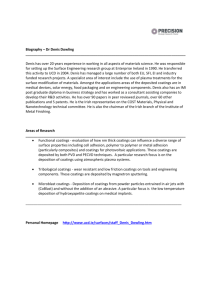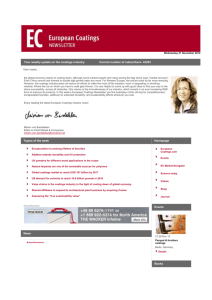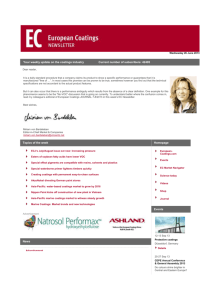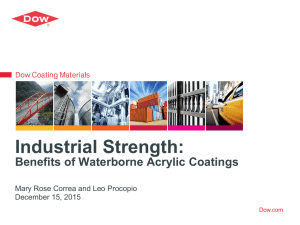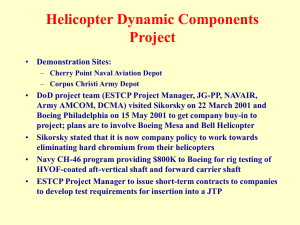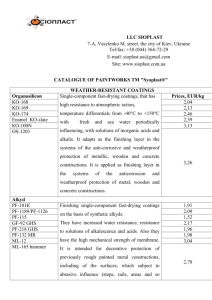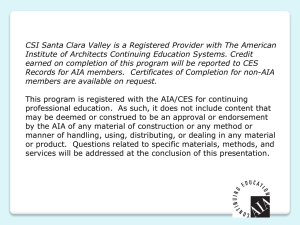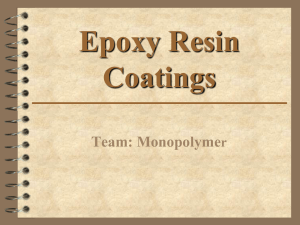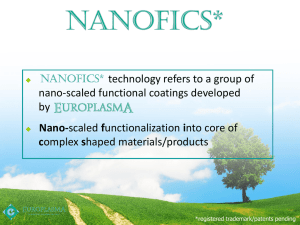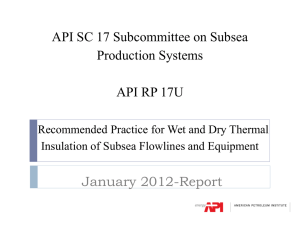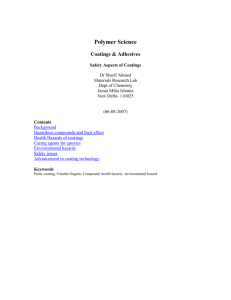Current 2K Waterborne Coatings
advertisement
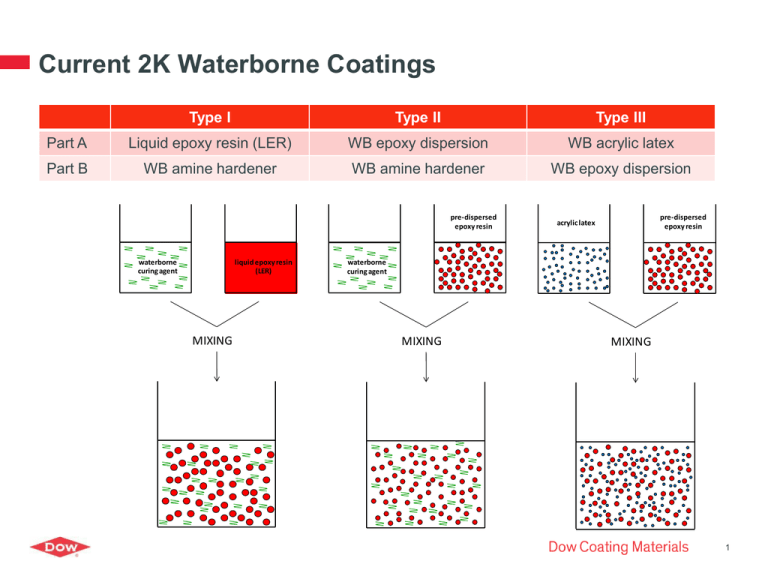
Current 2K Waterborne Coatings Type I Type II Type III Part A Liquid epoxy resin (LER) WB epoxy dispersion WB acrylic latex Part B WB amine hardener WB amine hardener WB epoxy dispersion pre-dispersed epoxy resin liquid epoxy resin (LER) waterborne curing agent MIXING pre-dispersed epoxy resin acrylic latex waterborne curing agent MIXING MIXING 1 New Technology: Acrylic-Epoxy Hybrids pre-dispersed AEH hybrid resin waterborne curing agent MIXING Part A = Acrylic-Epoxy Hybrid Resin • Acrylic and epoxy in the same particle • Epoxy-functional • Colloidal properties similar to acrylic latex • EEW similar to SER (low hardener demand) Part B = WB Amine Hardener 2 Benefits of New Technology: Acrylic-Epoxy Hybrids <50 g/L VOC capability Long pot life (~ 4 – 10 hour pot life) Fast cure (amine-epoxy reaction) Fast dry time (lacquer dry of acrylic) Fast hardness development Good durability (due to acrylic) Low viscosities for easy 2K mixing (i.e., a latex system) Potential for multi-substrate use in industrial and commercial architectural applications 3 60 Degree Gloss Gloss Retention on UV exposure 100 90 80 70 60 50 40 30 20 10 0 COM-P3 AEH-P1 QUVA Exposure Time (Hours) Acrylic component facilitates improved UV durability 4 New Applications for Waterborne Acrylics New Applications for Waterborne Acrylics Thermal Insulation Coatings Sound Damping Coatings 6 Thermal Insulation Coatings: A New Way to Insulate • Insulation is used to prevent heat loss (or gain) ‒ Energy conservation ($) ‒ Process control ‒ Safety – personnel protection (e.g., from burns) • Formulated with WB acrylic resins and low thermal conductivity fillers • Applied using traditional coating application methods, i.e., spray • Easily applied on complex geometries where traditional insulation is difficult to install • Insulation coating is fully adhered to the substrate/primer (CUI issue) • Suitable for up to ~350 F service temperature 7 Energy Efficiency: Energy Use in a Model Scenario Energy consumption (kWh) to maintain various internal temperatures for a six-hour period with a 125 mil DFT insulation coating. 22 – 36% less energy used No Coating Internal Temperature IC-1002-1 (hollow glass spheres) 180 F 250 F 325 F IC-1002-4 (silica aerogel) 0 0.2 0.4 0.6 0.8 1 1.2 Total Energy Consumed (kWh) 8 Benefits of Thermal Insulation Coatings WB Acrylic binders facilitate easy formulation of thermal insulation coatings, which offer : ‒ Low thermal conductivity (k-value) ‒ Personnel protection (safe touch) ‒ Insulating properties / Energy management ‒ Energy savings ‒ Improved inspection for CUI ‒ Ease of installation vs. traditional insulation 9 Sound Damping Coatings: Reducing Noise and Vibration What is Liquid Applied Sound Damping? • The use of coatings to reduce sound and vibration • Typically used in the Automotive industry as a replacement for bitumen or asphaltic pads used on interior of body • Applied by airless spray Where else could LASD be utilized? Any application that can benefit from sound management and reduced noise, vibration, and harshness (NVH): • • • Marine/Rail Automotive Agriculture & Construction Equipment • • • • • Washers/Dryers Dishwashers Refrigerators HVAC Units Air Conditioners • • • • • Floors/Roofs HVAC Ducts Elevator Shafts Service Conduits Boiler Rooms 10 WB Acrylic Binder Design and Effect on Sound Damping Range of Temperature Conditions and Performance Options Loss Factor Performance ASTM E-756 Base Beam: 0.8 mm x 12.7 mm x 200 mm (260 mm total length) Bake: 30 min (25˚C), 30 min (150˚C), Frequency Interpolation: 200 Hz Composite Loss Factor 0.35 0.30 0.25 0.20 0.15 0.10 0.05 0.00 -10.0 0.0 10.0 20.0 30.0 40.0 50.0 60.0 70.0 Degrees C Changes in Tg and other emulsion construction variables allow the tailoring of damping performance to individual specifications 11 Benefits of Sound Damping Coatings • Customizable solutions for sound damping • Applications Any application that can benefit from sound management and reduced noise, vibration and harshness (NVH): – – – – Automotive (Passenger Car, Truck, Van) Commercial Transportation (Marine, Rail, Bus) Agriculture & Construction Equipment (ACE) Appliances (Washing Machine, Dishwasher, Air Conditioner) • Excellent choice for LEED and Well Building Standard enhancements • Benefits vs. traditional solutions: – Improved damping performance & noise reduction – Up to 35% lower weight compared to alternative technology – Improved health & safety profile 12 Conclusions • Waterborne acrylics are one of the major technologies used in Industrial and Commercial Coatings • Wide range of compositions and corresponding performance is available • New advances are pushing the limits on performance, such as: ‒ Corrosion resistance ‒ VOC capability ‒ Improved balance of properties for 2K coatings • New types of functional coatings are expanding the use of acrylics: ‒ Insulation coatings ‒ Sound damping coatings 13
